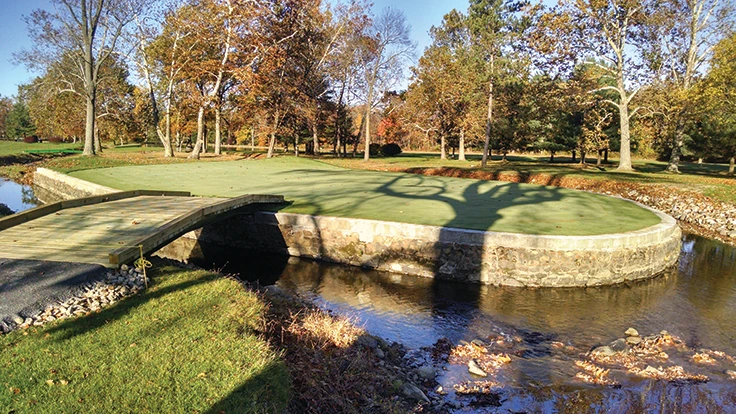
 Layers of sand, silt and what superintendent Faron Stoops calls “nastiness” had accumulated on a green Waynesboro Country Club members consider the most memorable square footage on their course.
Layers of sand, silt and what superintendent Faron Stoops calls “nastiness” had accumulated on a green Waynesboro Country Club members consider the most memorable square footage on their course.
Stoops and his crew tried masking the problem. They performed sod work – multiple times. They replaced poor soil with higher-quality mixes.
Finally, midway through May 2014, a persistent problem needed a permanent fix. One of those South Central Pennsylvania storms that Stoops thought would hit Waynesboro once every two decades caused the East Branch of Antietam Creek to overflow, submerging the 17th green for the fifth time in his tenure at the course.
Clean. Haul. Replace. Resod. Reopen. None of that was going to work following this storm, which dumped four inches of rain into an already saturated valley. One of the oldest island greens in the United States officially reached a crisis unlike any other in its 86-year history.
“The stream overflowed the wall,” says Stoops, who arrived at the club 14 years agos. “And when it came up over the top, it hit that front sod and just underwashed it and pushed the rest of the green up like an accordion or like a dog would hit on the floor on a throw rug. It ruined the entire green.”
The scene disturbed anybody with an emotional or financial interest in the green, a remaining piece of architect Roher Elder’s original nine holes. It also convinced the club to rebuild instead of continuing to repair the green.
Lacking a master plan because of the economic slowdown, Stoops leaned on connections established through the Central Pennsylvania GCSA. He sent images of the green to industry friends, and Hanover Country Club superintendent Bill Brooks referred Stoops to Pennsylvania-based architect Mark Fine.
The green proved a difficult study. Waynesboro didn’t have a supply of old sketches, aerials and paperwork, and Elder didn’t have a vast portfolio like Donald Ross, William Flynn, A.W. Tillinghast or other notable architects who designed course in the 1920s. Still, it became clear after Fine’s first visit that using pictures of the green before the submersion could aid the rebuild.
“There was a lot of history in this green,” Fine says. “I’m kind of a purist and I wanted to try to keep the hole and keep the history there and at the same time, we had a problem that we wanted to try and solve.”
 Construction near bodies of water have implications extending far beyond a course’s boundaries. To ensure the club was taking the proper approach, the site was studied by Mark Gutshall, principal and vice president of Land Studies, a Pennsylvania-based firm specializing in environmental restoration and land planning.
Construction near bodies of water have implications extending far beyond a course’s boundaries. To ensure the club was taking the proper approach, the site was studied by Mark Gutshall, principal and vice president of Land Studies, a Pennsylvania-based firm specializing in environmental restoration and land planning.
“It’s a historic hole and it’s around water,” Fine says. “Anytime you are working close to a stream like that, you have to make sure you are handling all the permits properly and if you are going to do anything that could potentially change something downstream, you have to make sure you have permits to do that.”
Multiple plans to rebuild the green were concocted, including an elaborate one that would have restored the entire floodplain. The primary objective of the plan pursued by the club involved reducing the possibility of water submerging the green.
GCBAA member George E. Ley Co. of Glenmoore, Pa., was selected as the contractor for the project. The company has worked with Fine on multiple Pennsylvania projects.
“My first impression was, ‘This green needs a lot of work,’” says Brian Ley, who served as the project manager. “A quarter of it had been washed off the top and the sod and other stuff was just eroded. It was just a mess when we got there.”
Waynesboro, fortunately, had a spare hole, allowing members to still play 18 while providing a distraction-free zone for construction crews to work. Rebuilding the green represented the biggest outside project Stoops has been involved with at Waynesboro.
The project enhanced the entire hole, with Ley and his crew also enlarging the tee and removing trees that made growing grass on parts of the green a challenge. The tree removal also opened a view of the 18th hole and the clubhouse.
The green was rebuilt to include surface drainage, something it lacked before the renovation. The size of the green increased from around 3,000 to 6,000 square feet. Encircling the expanded putting surface is 4 ½-foot collar. A local mason rebuilt the stone wall. Internal columns support the green. The old green rested 24-30 inches above the water level and the new green is 12 inches higher than the previous one, according to Ley. Crews also rebuilt the walking bridge to the green.
“We had to make sure we weren’t going to build a green that would collapse that wall, so we had to make sure the integrity of that wall was correct and then we were going to raise that wall up,” Fine says. “We didn’t want to build it at the same level. We wanted to raise that wall up so we were above that 50- or 100-year floodplain. We wanted to raise it up as high as it could without making it tilty.
“It’s a short hole, it’s an island green,” Fine adds. “If it gets perched up too high, it can just get very difficult. To get these things done right, it requires the right team, then we needed a contractor like George Ley, who I was confident would know how to do this and would do it at a good price and do it in a timely manner because the club wanted this hole back in play as quickly as possible.”

The green was sodded with Pure bentgrass, and Stoops says he’s “hopeful” increased sunlight will prevent Poa annua from encroaching on the putting surface. Dispersing foot traffic – a challenge on every island green – is a concern. Stoops, though, envisions the changes producing an easier-to-maintain hole.
The green endured multiple tests this past spring, as Waynesboro experienced an ultra-soggy stretch in late May and early June. “Every three days we would get an inch or more in one rainstorm,” Stoops says. “Everybody was calling me and asking, ‘How did it work out?’ I kept on saying, ‘No problem, no problem.’”
After 400 days of analysis, construction and grow-in, Waynesboro reopened the hole with a ceremony on Aug. 1. “The reception has been great,” Stoops says. “The members love it.”
The project represents an example of how separate parties can quickly come together to solve a problem. Stoops, after all, had never met Fine or Ley before last year. Ley says Stoops and Fine’s personalities made the project “an easygoing job.” And this job, unlike the ones Stoops and crews encountered at 17th following big storms, included a tidy result.
“Just knowing that you accomplished the goal of making a signature hole for a course is really satisfying,” Ley says.

Explore the October 2015 Issue
Check out more from this issue and find your next story to read.
Latest from Golf Course Industry
- From the publisher’s pen: Conscientious of a bigger role
- Bernhard and Company partners with Laguna Golf Phuket
- Terre Blanche showcases environmental stewardship
- VIDEO: Introducing our December issue
- Bernhard and Company introduces Soil Scout
- Nu-Pipe donates to GCSAA Foundation’s Centennial Campaign
- GCSAA enhances golf course BMP tool
- Melrose leadership programs sending 18 to 2026 GCSAA Conference and Trade Show





